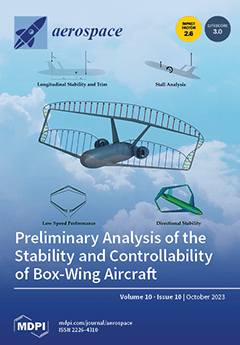Shock wave/turbulent boundary layer interaction (SBLI) is one of the most common physical phenomena in transonic wing and supersonic aircraft. In this study, the compression ramp SBLI (CR-SBLI) was simulated at a 24° corner at Mach 2.84 using the open-source OpenFOAM improved delayed
[...] Read more.
Shock wave/turbulent boundary layer interaction (SBLI) is one of the most common physical phenomena in transonic wing and supersonic aircraft. In this study, the compression ramp SBLI (CR-SBLI) was simulated at a 24° corner at Mach 2.84 using the open-source OpenFOAM improved delayed detached eddy simulation (IDDES) turbulence model and the “Rescaling and Recycling” method at high Reynolds number
. The results of the control effect of the jet vortex generator on CR-SBLI showed that the jet array can effectively reduce the length of the separation zone. The simulation results of different jet parameters are obtained. With the increasing jet angle, the reduction in the length of the separation zone first increased and then decreased. In this work, when the jet angle was 60°, the location of the separation point was
, which was smaller than other jet angles. The different distances of the jet array also had a great influence. When the distance between the jet and the corner
, the location of the separation point
was smaller than that when
. A closer distance between the jet hole and the corner caused the vortex structures to squeeze each other, preventing the formation of a complete vortex structure. On the other hand, when the jet was farther away, the vortex structures could separate effectively before reaching the shock wave, resulting in a better inhibition of SBLI. The simulation primarily focused on exploring the effects of the jet angle and distance, and we obtained the jet parameters that provided the best control effect, effectively reducing the length of the CR-SBLI separation zone.
Full article





